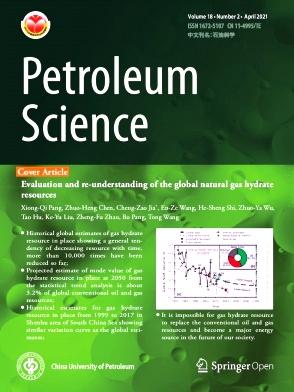Truncated Gauss-Newton full-waveform inversion of pure quasi-P waves in vertical transverse isotropic media
IF 6.1
1区 工程技术
Q2 ENERGY & FUELS
引用次数: 0
Abstract
Full-waveform inversion (FWI) uses the full information of seismic data to obtain a quantitative estimation of subsurface physical parameters. Anisotropic FWI has the potential to recover high-resolution velocity and anisotropy parameter models, which are critical for imaging the long-offset and wide-azimuth data. We develop an acoustic anisotropic FWI method based on a simplified pure quasi P-wave (qP-wave) equation, which can be solved efficiently and is beneficial for the subsequent inversion. Using the inverse Hessian operator to precondition the functional gradients helps to reduce the parameter tradeoff in the multi-parameter inversion. To balance the accuracy and efficiency, we extend the truncated Gauss-Newton (TGN) method into FWI of pure qP-waves in vertical transverse isotropic (VTI) media. The inversion is performed in a nested way: a linear inner loop and a nonlinear outer loop. We derive the formulation of Hessian-vector products for pure qP-waves in VTI media based on the Lagrange multiplier method and compute the model update by solving a Gauss-Newton linear system via a matrix-free conjugate gradient method. A suitable preconditioner and the Eisenstat and Walker stopping criterion for the inner iterations are used to accelerate the convergence and avoid prohibitive computational cost. We test the proposed FWI method on several synthetic data sets. Inversion results reveal that the pure acoustic VTI FWI exhibits greater accuracy than the conventional pseudoacoustic VTI FWI. Additionally, the TGN method proves effective in mitigating the parameter crosstalk and increasing the accuracy of anisotropy parameters.
垂直横向各向同性介质中纯准 P 波的截断高斯-牛顿全波形反演
全波形反演(FWI)利用地震数据的全部信息,对地下物理参数进行定量估算。各向异性全波反演具有恢复高分辨率速度和各向异性参数模型的潜力,这对于长偏移和宽方位数据成像至关重要。我们基于简化的纯准 P 波(qP 波)方程开发了一种声学各向异性 FWI 方法,该方法可以高效求解,有利于后续反演。使用逆黑森算子对函数梯度进行预处理,有助于减少多参数反演中的参数权衡。为了平衡精度和效率,我们将截断高斯-牛顿(TGN)方法扩展到垂直横向各向同性(VTI)介质中纯 qP 波的全波反演。反演以嵌套方式进行:线性内循环和非线性外循环。我们基于拉格朗日乘法推导出了 VTI 介质中纯 qP 波的 Hessian 向量乘积公式,并通过无矩阵共轭梯度法求解高斯-牛顿线性系统来计算模型更新。为了加速收敛并避免过高的计算成本,我们使用了合适的预处理器以及内部迭代的 Eisenstat 和 Walker 停止准则。我们在几个合成数据集上测试了所提出的 FWI 方法。反演结果表明,纯声学 VTI FWI 比传统的伪声学 VTI FWI 具有更高的精度。此外,TGN 方法还能有效缓解参数串扰,提高各向异性参数的准确性。
本文章由计算机程序翻译,如有差异,请以英文原文为准。
求助全文
约1分钟内获得全文
求助全文
来源期刊

Petroleum Science
地学-地球化学与地球物理
CiteScore
7.70
自引率
16.10%
发文量
311
审稿时长
63 days
期刊介绍:
Petroleum Science is the only English journal in China on petroleum science and technology that is intended for professionals engaged in petroleum science research and technical applications all over the world, as well as the managerial personnel of oil companies. It covers petroleum geology, petroleum geophysics, petroleum engineering, petrochemistry & chemical engineering, petroleum mechanics, and economic management. It aims to introduce the latest results in oil industry research in China, promote cooperation in petroleum science research between China and the rest of the world, and build a bridge for scientific communication between China and the world.
 求助内容:
求助内容: 应助结果提醒方式:
应助结果提醒方式:


